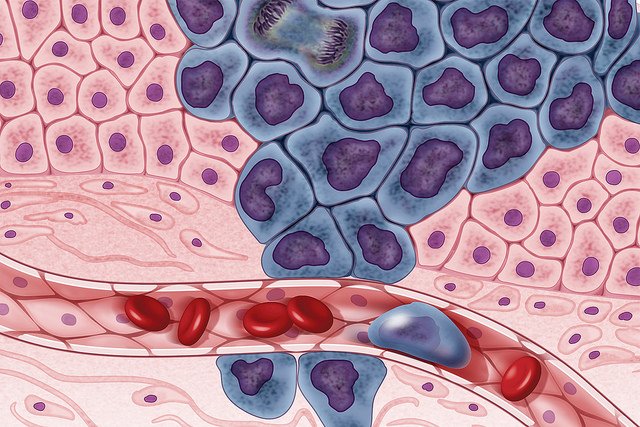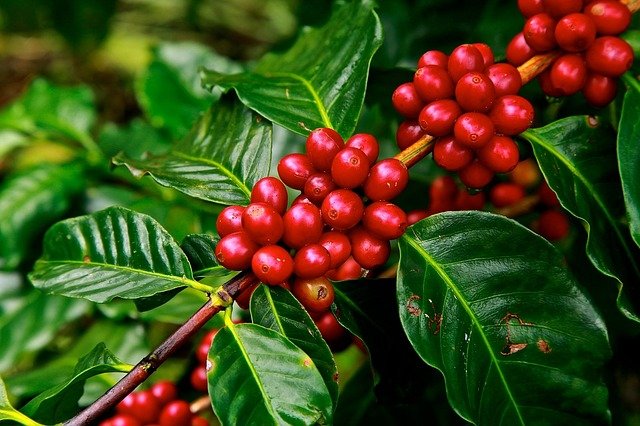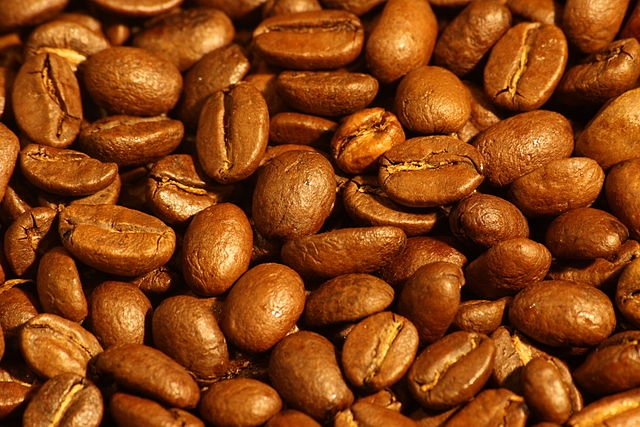Oh, how much some of us love coffee. The sweet aroma, the flavor. O boy, coffee really excites me. I drink a lot of coffee daily, and I know that most of us do as well. When I think about the taste, I realize why it's one of the most consumed drinks in the world. That's why when I got the information that coffee is connected to cancer, I was really surprised, in fact angry I must confess. It's like having someone tell you to your face that your very much loved wife or girlfriend is bad for you and in fact she can cause a problem that can kill you (damn, no way).
I had to look into it myself, and all the information I gathered, I would be sharing with us. And please, smile, cause there's good news, my findings did not correspond completely with what these guys are saying. But then, there are other things we need to know and simple advise that I would be giving. So just relax yourself and let's do this together guys. Let's go...
[Cup of coffee. Source: Wikimedia Commons. Author: Julius Schorzman. CC-BY-SA-2.0 Licensed]
Cancer
I'm sure that we've all read a lot about cancer, but to simply put, cancer can be said to be the uncontrolled growth of abnormal cells in any part of the body. Now, it's these abnormal cells that are called cancer cells. These cells actually can get into normal body tissues. The name of the cancer is given based on the tissue that the abnormal cells actually originated from. Let's take for example, there's a cancer called breast cancer, because the abnormal cells originated from the breast. There are so many other examples of cancer e.g Lung cancer, colon cancer etc. Actually, there are very well over two hundred different types of cancer. Whatever it is that can make a normal and healthy body cell to start developing abnormally can be said to be a potential cause of cancer. Normally, cancer can be caused by the following agents- pathogens, chemical exposures, sometimes cancer can be caused by toxic compound exposures, human genetics etc.
Now, individuals may notice signs depending on the particular type of cancer as well as the grade of the cancer. Even though there are not very specific signs, patients may experience voice change, tissue masses, skin changes, sometimes pain, they may notice change in the functioning of the bladder as well as bowel changes, lumps, sometimes unusual bleeding and so on. There are so many ways of testing for cancer cells in an individual or screening as it is sometimes called. But the most common diagnosis is done by examining a biopsy sample of body tissue that is suspected of carrying cancer cells.
A biopsy is the removal of tissue from any part of the body to examine it for disease. Some may remove a small tissue sample with a needle while others may surgically remove a suspicious nodule or lump. Source
There are different stages of cancer, and this is actually known by the biopsy results. By knowing what the biopsy result is, one can know the type of cancer and to what extent the cancer has spread. This helps the caregivers to determine what kind of treatment protocols that are needed. Normally, the staging methods given are between zero and four. In which case, the more severe cancer types are stages three and four. Now, based upon the type of cancer as well as the stage of the cancer, treatment protocols differ. The treatments usually involve one or a combination of the following- there's surgery, there's radiation therapy as well as chemotherapy. There are also alternative treatments as well as home remedies, but it's advisable that patients discuss with their cancer doctors before use. The survival rate of cancer actually range from excellent to poor. Unfortunately, individuals that have cancer at the stages three and four often have a poor survival rate.

[Cancer cells. Source: Flickr. Author: NIH Image Gallery. CCO Lincensed]
Coffee
Coffee is simply a brewed drink. It is actually prepared from roasted coffee seeds (also called coffee beans) of berries from coffea plant. Coffea has its origin in tropical Africa, specifically from Sudan as well as Ethiopia. It is actually exported from Africa to other countries in the world. Guess what, currently coffee plant is cultivated in very well over seventy countries. Basically, it is cultivated in the equatorial regions. For example, it is cultivated in the Americas, India as well as in Southeast Asian. As soon as they are ripe, the coffee berries are picked, next they are processed, and then dried. These dried coffee seeds can be also called beans; this is because of the way they look alike. Now, the dried seeds or beans are roasted to different degrees, depending on the flavor of one's desire. Coffee is a little bit acidic and it has a stimulating effect, hence the wonderful feeling humans get when we drink it. It is among the most popular drinks in the whole world. It can be served hot as well as iced. But guys, I really do like it hot. Although, I know a few people that prefer it iced. Well, we all have our likes and dislikes, different strokes for different folks.
In the processing of coffee, berries are usually picked by hand. The picking of berries by hand is labor-intensive. It involves picking the berries that are at the highest point of ripeness. Machines can also be used to harvest berries. After that is done (i.e the picking), one of two methods can be used to process the green coffee- the wet process method, which involves fermentation and produces a mild coffee, and the dry process, which is a less labor-intensive process. The flesh of the picked berries are removed using machines, then the seeds are fermented in order to get rid of the slimy layer of mucilage that are still on the seed. After the fermentation is done, the seeds are properly washed with large quantities of fresh water on order to remove the residue of the fermentation, as a result of this, the processing of coffee produces very massive amounts of wastewater. And then, the seeds are dried. The least used method of drying coffee happens to be the best method; and it involves the use of drying tables. On the tables, the fermented coffee is actually spread. Since the table is raised, it allows for air to dry the coffee from all sides.
The coffee produced in Africa are usually processed this way and some other coffee farms around the globe are actually beginning to use this method as well. After the coffee is dried, then it is sorted and there after labeled as green coffee. Sometimes, companies use machines to dry the coffee seeds. But this is usually done in regions where the humidity is very high. Hence, companies that use these machines are located in places with very high humidity.

[Ripe Coffee beans. Source: Pixabay. Author: Skeeze. CCO Licensed]
Roasting
Yeah guys, roasting is the next step in the processing of coffee. Actually, the coffee we buy is in a roasted state majorly. It can be either sold to the consumer already roasted or the consumer roast it him/herself. The taste of the coffee is influenced by the roasting process. Roasting actually starts when the temperature that is inside the coffee bean reaches there about 200 degree Celsius. Although, seeds differ in their moisture content as well as their density, hence the seeds get to roast at different rates. There's a term caramelization, this occurs when the intense heat gets to break down starches, hence altering them to simple sugars; as a result, they start to look brown. Hence, cameralization brings about the changing of the coffee bean to color brown. During roasting process, sucrose is lost and may completely be lost in darker roast. The acids and aromatic oils start to weaken, hence altering the flavor. At the same time, some other oils begin to develop; all these occur at about 205 degree Celsius. Caffeol is actually one of the oils that begin to develop at this temperature and it is the oil majorly responsible for the flavor and the aroma of coffee. The human eye can be used to perceive the color of the roasted bean, hence labeling it as light, next medium light, then medium, then we have medium dark, then dark, and finally we have very dark.

[Medium roasted coffee beans. Source: Wikimedia Commons. Author: Ragesoss. CC-BY-SA-3.0 Licensed]
Now, let's discuss- can coffee cause cancer?
Yeah guys, we've talked about how popular coffee is, and how much people love this drink worldwide. But many concerns are growing claiming that the consumption of coffee may actually cause cancer. There are other claims as well that coffee offers fantastic health benefits and in contrary to what the other set of claims are, that coffee may in fact prevent cancer. Wow, quite a debate right? Now let's look at what evidence says?
First and foremost, there is no research anywhere that has proven that coffee is in anyway a carcinogen. And the truth is that we all know that cancer is a very complex disease. It's actually not easy to know it's cause. There have been so many research work done to investigate different substances in order to know exactly the substances that may increase the risk for cancer. Any substance that has the potential of causing cancer is called a carcinogen. Over a thousand research works have been done by the International Agency for Research on Cancer (IARC) in animals and humans, and all these research works did not find enough evidence to prove that coffee is a carcinogen. Now, let me tell us why there's been so many claims that coffee may cause cancer- people started suggesting this because of the substance that roasted coffee beans contain. The name of this substance is called Acrylamide.

[Acrylamide structural formula. Source: Wikimedia Commons. Author: Jü. Public domain CCO Licensed]
Acrylamide is actually a byproduct of coffee roasting process. Acrylamide is considered a probable carcinogen by IARC. What this actually means is that there is substantial evidence that suggests that this substance acrylamide may actually cause cancer in animals. But then, more research has to be done to determine if that's actually true. The truth is that coffee on it's own doesn't contain acrylamide. It comes from the roasting process as I mentioned above. Hence, individuals that are skeptical about acrylamide should simply choose a different type of coffee. It's been found that acrylamide may also occur in starchy foods that usually need to be cooked at very high temperatures, let's take for example potato chips and fries, cigarette smoke, acrylamide is also found to occur in industrial processes, e.g plastic making, dyes making as well as paper making. It is also known to occur in food packaging as well as in some adhesives, although in small quantities.
The truth is that people should ensure that they stop frying foods and toasting bread until they are dark brown. Don't bake or roast potatoes until its dark brown. Fry foods light. That way, you reduce your exposure to acrylamide. Hey guys, most cancer occur as a result of a combination of different factors, such as environment, individual's genes, as well as lifestyle. Some of the main factors may include- unhealthy diet, smoking, alcohol drinking, being overweight, exposure to sun, work environment- for example, being exposed to specific radiation as well as chemicals. Consumption of coffee is unlikely to be a risk for cancer, especially if your consumption of coffee is part of a healthy lifestyle. Truth be told, roasted coffee beans actually do contain some acrylamide. Hence, it's advisable for coffee drinkers to avoid this substance by choosing lightly roasted coffee beans. Remember, acrylamide occur when the coffee bean is roasted to dark brown. Hence, go for light, or medium light but not dark. You can see that with your naked eyes. The level of roasting an easily be seen when you take a good look at the coffee. And please note, it is advised that adults shouldn't consume more than four cups of coffee daily. Remember, too much of a good thing may become bad. Hence guys, let's enjoy drinking our tasty coffee, but with moderation. Feel free to check my references for more information.
Thanks for reading!
References
Image Sources
All images used here are from free sources and liable for commercial use
all licensed under the Creative Commons.


To the question in your title, my Magic 8-Ball says:
Hi! I'm a bot, and this answer was posted automatically. Check this post out for more information.
Downvoting a post can decrease pending rewards and make it less visible. Common reasons:
Submit
This post has been voted on by the steemstem curation team and voting trail.
There is more to SteemSTEM than just writing posts, check here for some more tips on being a community member. You can also join our discord here to get to know the rest of the community!
Downvoting a post can decrease pending rewards and make it less visible. Common reasons:
Submit
Nice write-up. We take coffee moderately and medical checkup is advised.
Downvoting a post can decrease pending rewards and make it less visible. Common reasons:
Submit